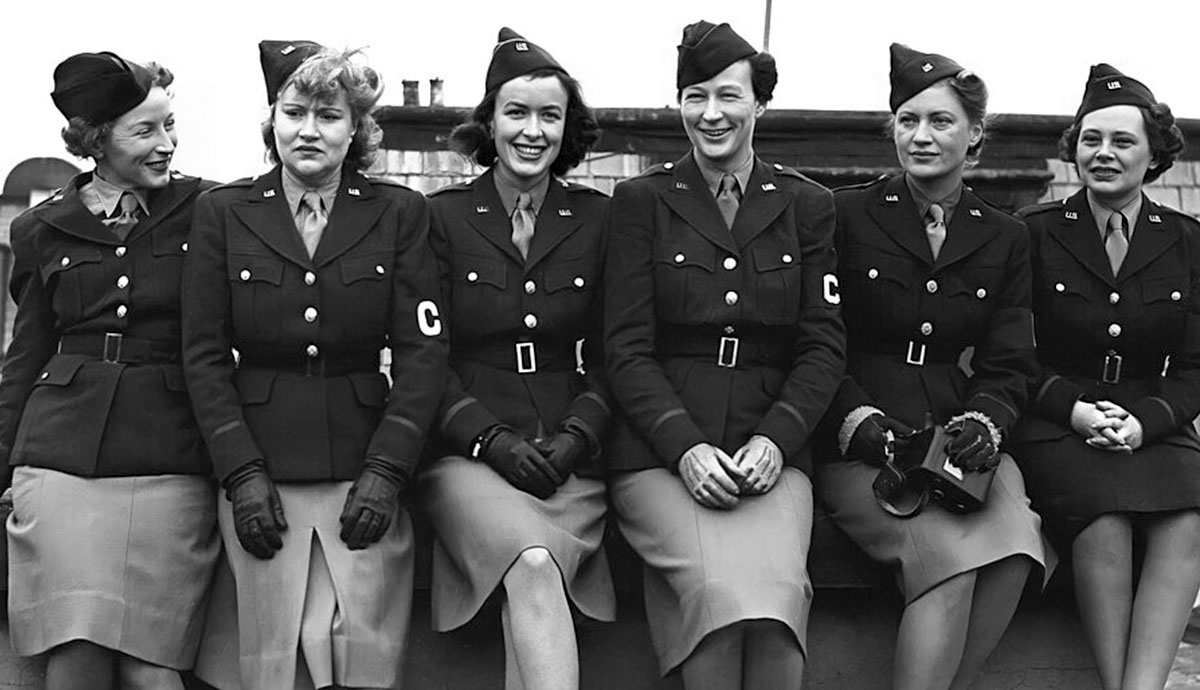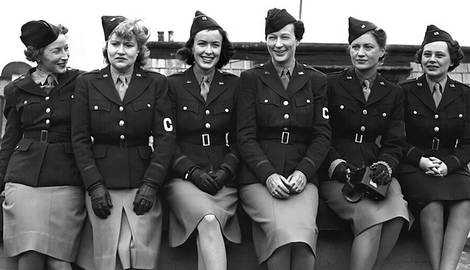
George Santayana wrote in 1905 that those who cannot remember the past are condemned to repeat it. This universal truth is specifically poignant when we think about World War II and the pivotal role that many women played during this difficult time. Most countries banned women from being involved in physical combat, but this didn’t stop plenty of iconic women from finding ways of playing pivotal roles in logistical and tactical initiatives.
1. Lee Miller: The Photojournalist of World War II

Lee Miller remains one of the best-known female photojournalists of World War II. Her legacy, as it stands, would not have existed if her son had not discovered the extent of her war photography in the attic of their rural English home after her death. Miller was a model, surrealist artist, and war photographer. When her modeling career ended she moved to Paris to seek out Man Ray, who became her lover and her creative partner. Their surrealist work in photography became the blueprint for her personal style that managed to capture the shocking realities of war.

While it was usually forbidden for women to be present in combat, Miller found herself present at the Blitz, in the aftermath of D-Day, during the liberation of Paris, the Battle of Alsace, and at the military’s entry into Nazi Concentration camps at Buchenwald and Dachau. Her photography at the time was sent directly back to Vogue who would publish her visual stories throughout the war, marking Miller’s efforts to merge the fashion publication with news reporting for the first time. From pictures of dead SS soldiers floating down a canal to starved Jewish prisoners at the death camps on the day of liberation, Vogue published extremely graphic content captured by Miller. This transformed the prime function of the magazine at the time.
Just after her famous photos of the liberation of the Dachau camp were taken, Lee and Life’s photojournalist David E Scherman went to Hitler’s apartment in the center of Munich. The timing of their trip would become known as the day when Hitler committed suicide with his wife. This fact was still unknown to Miller and Scherman who climbed into his tub to wash off the filth of the day. With soiled boots staining the white floor of the bathroom and propaganda pictures marking the wall, they photographed each other bathing in Hitler’s tub.
2. Josephine Baker

There is very little that Josephine Baker didn’t know about resistance. After leaving her native Louisiana to star in a French cabaret on the Champs Elysee she became famous in France. During her rise to fame in Paris, she became an iconic entertainer of the Jazz Age, transcending racial barriers and becoming the richest Black woman of the time. She was nicknamed The Creole Goddess of France and she became the first African-American woman to star in a motion picture and perform for an integrated cast at the American Concert Hall.
Her life in Paris made her particularly interesting to Jacques Abtey, the head of French counter-military intelligence. Her fame and her job allowed her to travel during the war without suspicion. Baker used her celebrity to gain access to high-ranking Axis officials and attended diplomatic parties to gain secret knowledge on German intelligence and troop movements in Paris. Abtey asked Baker to engage in espionage missions for the French after it fell to Nazi occupation, to which she said yes.

Baker smuggled hundreds of classified documents and visas for other spies and resistance workers who hid in her Chateau. When the Chateau was raided by German troops, she fled to England, with visas and secret information all written on her sheet music in invisible ink. Discovery of such information or any evidence of illicit activities at the Chateau would have meant certain death for Baker, yet she never stopped seeking out and gathering information.
By the time she left for England, she was basically public enemy number one of the Nazis. She was a successful Black woman in an interracial marriage with a Jewish man, who was also openly bisexual and had multiple long-term, semi-public relationships with other women. She returned after the war was over to raise money for the starving French people of Paris.
After the city had started to rebuild she returned to America to take part in the Civil rights movement. She was the only woman who gave a speech at the March on Washington in 1968. She dedicated her speech to other female civil rights activists around the world. Josephine was awarded with the Croix de Guerre and the Rosette de la Résistance. She was also named a Chevalier de Légion d’honneur, the highest order of merit for military and civil action in France.
3. Marlene Dietrich

Marlene Dietrich was a singer, actress, and dancer who began her career in Vaudeville skits in Berlin. Dietrich was known for her beauty, fame, and her incredible efforts during World War II. In 1937, while residing in the United States, she was approached by German authorities who asked her to star in propaganda films. Allegedly, she was personally requested by Hitler. After learning about this, Dietrich went on a radio show in Germany and said that Hitler was an idiot.

At the beginning of the war, she was one of the first celebrities who publicly joined the war effort. She hosted live gigs in order to raise money to support troops. Dietrich also worked with the U.S. Office of Strategic Services (O.S.S.), the predecessor of today’s CIA, to record a series of anti-Nazi albums, using propaganda to weaken the morale of Nazi troops. During the war, she traveled and performed over 500 shows, suffering from influenza and regular episodes of frostbite. Many of these shows took place on the frontlines, putting her in direct danger.
4. Nancy Wake

Nancy Wake is another remarkable woman whose opposition to Nazi forces drove her to engage in missions that threatened her life on a daily basis. She was so good at escaping the German forces that she earned the nickname The White Mouse by SS Soldiers. Raised in New Zealand and Maui, she became one of the first-ever Mauri women to marry a European man. She relocated to France after traveling to Europe to study journalism. Like many women, Wake began driving ambulance cars at the onset of the war, but once France fell to the Nazi occupation, Nancy and her husband began working for the Pat O’Leary Escape Network, led by Ian Garrow and Albert Guerisse.
Their mission was to help the Allied airmen escape the German Forces and help them make their way to the neutral Spain. They successfully spared the lives of hundreds of soldiers. Once the Germans received intelligence about the Pat O’Leary escape network, Nancy and her husband fled to Spain too. Nancy arrived safely, however, her husband did not. He was captured and executed by the German forces.

Despite this shocking loss, Nancy continued with her espionage work. Nancy traveled from Spain to England to join the Special Operations Executive (SOE) under the code name Hélène. She jumped out of a plane and parachuted into occupied France to begin her new mission with The Maquis, a resistance guerilla group that had many factions around France. The Maquis were made up of mostly working-class young men who had escaped to the mountains in order to avoid deportation to Germany. At one point during her time in France, Nancy is said to have cycled up to 300 miles at once in order to deliver an emergency report back to London. She was a recipient of the George Medal, the Medal of Freedom, the Legion d’Honneur, the Badge in Gold, and the Companion of the Order of Australia. Her obituary in the New York Times included the title The Socialite Who Killed A Nazi With Her Bare Hands.
5. Virginia Hall: The Female Spy of World War II

Virginia Hall was inspired by the freedom and bohemian spirit of Paris during a visit in her early twenties. During her long attempts to become a diplomat, Hall faced repeated and explicit rejections of her applications to the U.S. State Department due to her disability. Hall had her leg amputated after a hunting accident. She spent many years traveling to Europe, following her diplomatic dreams and finding herself restricted to the administration desk.
She was scouted and flown to France in order to work as a secret agent during the occupation of France. This became a perfect way for her to use her intelligence, charisma, and ambition. She successfully rescued twelve of her fellow agents from an internment camp, evaded the treachery of a double-crossing priest, and undertook a journey over the Pyrenees into Spain—only to return to France to continue fighting for its freedom.

She also played a crucial role in recruiting large networks of resistance fighters. She regularly moved through occupied areas of France, taking big risks to find and guard safe drop zones needed for the delivery of food and medical supplies. Without the work of women like Hall, the efforts of resistance forces would simply have been impossible. She remains known as one of the most valued spies of World War II. Her bravery and innovative spirit contributed to the enlistment of women in the Secret Service. She passed in 1982 at Adventist Hospital in Rockville, Maryland.








